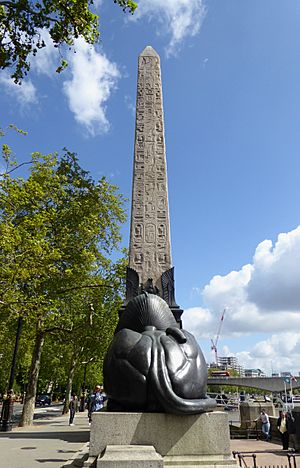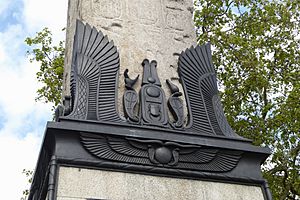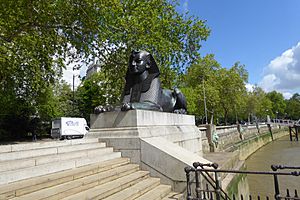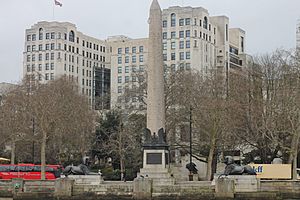Cleopatra's Needle, London facts for kids
Cleopatra's Needle in London is a tall, ancient Egyptian stone pillar called an obelisk. It's one of three similar obelisks around the world. You can find it in the City of Westminster, right by the Victoria Embankment and the Golden Jubilee Bridges. It's also very close to the Embankment underground station.
This amazing obelisk was given to the United Kingdom in 1819. The ruler of Egypt and Sudan, Muhammad Ali, presented it as a gift. It was meant to celebrate the victories of Lord Nelson at the Battle of the Nile and Sir Ralph Abercromby at the Battle of Alexandria in 1801. Even though the British government liked the gift, they didn't want to pay for its expensive journey to London. The obelisk is covered in ancient Egyptian writing called hieroglyphs.
Contents
The Ancient History of the Obelisk
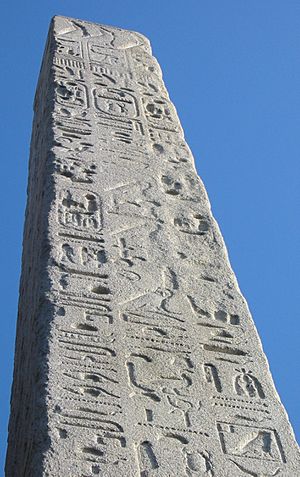
This obelisk was first put up in the ancient Egyptian city of Heliopolis. This happened around 1450 BC, ordered by Thutmose III, an Egyptian pharaoh. The obelisk is made from granite, a very hard stone. This stone came all the way from the quarries of Aswan, near the Nile River.
Thutmose III had one column of writing carved on each side of the obelisk. These writings were later translated by E. A. Wallis Budge. About 200 years later, another pharaoh named Ramesses II added more carvings. These new carvings are in two columns on each side. They tell about his military victories.
Later, the Romans moved the obelisks to Alexandria. They were placed in a temple called the Caesareum in 12 BC. This temple was built by Cleopatra to honor Mark Antony or Julius Caesar. Over time, the obelisks fell over. This actually helped protect them! Being buried in the sand kept most of their hieroglyphs safe from the weather.
The Amazing Journey to London
The obelisk stayed in Alexandria until 1877. That's when Sir William James Erasmus Wilson paid a huge amount of money to bring it to London. It cost about £10,000, which would be over £1,000,000 today!
The obelisk had been buried in sand for almost 2,000 years. Workers dug it out and put it inside a giant iron cylinder. This cylinder was 92 feet (28 m) long and 16 feet (4.9 m) wide. It was designed by engineer John Dixon and was named Cleopatra. It was built in pieces and then put together around the obelisk in Alexandria.
The Cleopatra cylinder was like a floating boat. It had a rudder and a mast for balance. It was meant to be towed to London by another ship called the Olga.
A Stormy Sea Voyage
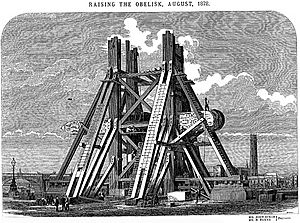
The journey was very dangerous. On October 14, 1877, a big storm hit in the Bay of Biscay. The Cleopatra started rolling wildly and became impossible to control. The Olga sent a rescue boat with six brave volunteers. Sadly, the boat flipped over, and all six crew members were lost. Their names are now on a bronze plaque at the base of the obelisk in London.
The captain of the Olga managed to rescue the crew from the Cleopatra. He reported that the Cleopatra was "abandoned and sinking." But it didn't sink! It floated for four more days. Spanish fishing boats found it, and then a steamer ship called the Fitzmaurice rescued it. The Cleopatra was taken to Ferrol in Spain for repairs.
After repairs, a tugboat named Anglia towed the Cleopatra to the Thames River. When they arrived on January 21, 1878, the schoolchildren in Gravesend were given the day off to celebrate! The London obelisk was finally put up on the Victoria Embankment on September 12, 1878.
Setting Up the Needle
The main stone mason who worked on the obelisk's foundation was William Henry Gould.
A Secret Time Capsule
When the obelisk was put up in 1878, a time capsule was hidden inside its base. This capsule contained many interesting items from that time. It had 12 photographs of English women, hairpins, cigars, and tobacco pipes. There were also imperial weights, a baby's bottle, children's toys, and a razor.
Other items included a bronze model of the monument and a full set of British coins. There was also a rupee, a picture of Queen Victoria, and a history of the obelisk's journey. Plans on vellum, a translation of the hieroglyphs, and Bibles in different languages were also included. Finally, it had a copy of John 3:16 in 215 languages, a Whitaker's Almanack, a Bradshaw Railway Guide, a map of London, and copies of 10 daily newspapers.
The Sphinxes and War Damage
Cleopatra's Needle is guarded by two fake-Egyptian sphinxes. These sphinxes were designed by the English architect George John Vulliamy. They are made of bronze and have hieroglyphic writings on them. The writing says "the good god, Thutmose III given life."
It looks like the sphinxes are facing the wrong way. They seem to be looking at the Needle instead of guarding it! The Embankment area has other Egyptian decorations too, like sphinxes on the armrests of benches.
During World War I, on September 4, 1917, a bomb from a German air raid landed near the needle. You can still see the damage today. There are shrapnel holes and marks on the right-hand sphinx. This damage was left unrepaired to remember the event. The obelisk and sphinxes were restored in 2005.


